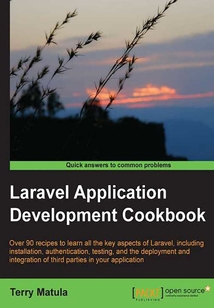舉報 

會員
Laravel Application Development Cookbook
最新章節:
Index
Gettogripswithanewtechnology,understandwhatitisandwhatitcandoforyou,andthengettoworkwiththemostimportantfeaturesandtasks.AshortandpreciseguidetogetyoustartedwithEaselJS,helpingyoutocreatesomecoolapplicationsandgames.EaselJSgreatlysimplifiesapplicationdevelopmentinHTML5CanvasusingasyntaxandanarchitectureverysimilartotheActionScript3.0language.Asaresult,Flash/Flexdeveloperswillimmediatelyfeelathomebutit’sveryeasytolearnevenifyou'veneveropenedFlashinyourlife.ThebooktargetsWebdesigners,animators,Digitalcontentproducers,andFlashandFlexdevelopers.
目錄(122章)
倒序
- 封面
- 版權信息
- Credits
- About the Author
- About the Reviewers
- www.PacktPub.com
- Preface
- Chapter 1. Setting Up and Installing Laravel
- Introduction
- Installing Laravel as a git submodule
- Setting up a virtual host and development environment in Apache
- Creating "clean" URLs
- Configuring Laravel
- Using Laravel with Sublime Text 2
- Setting up your IDE to autocomplete Laravel's namespaces
- Using Autoloader to map a class name to its file
- Creating advanced Autoloaders with namespaces and directories
- Chapter 2. Using Forms and Gathering Input
- Introduction
- Creating a simple form
- Gathering form input to display on another page
- Validating user input
- Creating a file uploader
- Validating a file upload
- Creating a custom error message
- Adding a honey pot to a form
- Uploading an image using Redactor
- Cropping an image with Jcrop
- Creating an autocomplete text input
- Making a CAPTCHA-style spam catcher
- Chapter 3. Authenticating Your Application
- Introduction
- Setting up and configuring the Auth library
- Creating an authentication system
- Retrieving and updating user info after logging in
- Restricting access to certain pages
- Setting up OAuth with the HybridAuth package
- Using OpenID for logins
- Logging in using Facebook credentials
- Logging in using Twitter credentials
- Logging in using LinkedIn
- Chapter 4. Storing and Using Data
- Introduction
- Creating data tables using migrations and schemas
- Querying using raw SQL statements
- Querying using Fluent
- Querying using Eloquent ORM
- Using automatic validation in models
- Using advanced Eloquent and relationships
- Creating a CRUD system
- Importing a CSV using Eloquent
- Using RSS as a data source
- Using attributes to change table column names
- Using a non-Eloquent ORM in Laravel
- Chapter 5. Using Controllers and Routes for URLs and APIs
- Introduction
- Creating a basic controller
- Creating a route using a closure
- Creating a RESTful controller
- Using advanced routing
- Using a filter on the route
- Using route groups
- Building a RESTful API with routes
- Using named routes
- Using a subdomain in your route
- Chapter 6. Displaying Your Views
- Introduction
- Creating and using a basic view
- Passing data into a view
- Loading a view into another view/nested views
- Adding assets
- Creating a view using Blade
- Using TWIG templates
- Utilizing advanced Blade usage
- Creating localization of content
- Creating menus in Laravel
- Integrating with Bootstrap
- Using named views and view composers
- Chapter 7. Creating and Using Composer Packages
- Introduction
- Downloading and installing packages
- Using the Generators package to set up an app
- Creating a Composer package in Laravel
- Adding your Composer package to Packagist
- Adding a non-Packagist package to Composer
- Creating a custom artisan command
- Chapter 8. Using Ajax and jQuery
- Introduction
- Getting data from another page
- Setting up a controller to return JSON data
- Creating an Ajax search function
- Creating and validating a user using Ajax
- Filtering data based on checkbox selection
- Making an Ajax newsletter sign-up box
- Sending an e-mail using Laravel and jQuery
- Creating a sortable table using jQuery and Laravel
- Chapter 9. Using Security and Sessions Effectively
- Introduction
- Encrypting and decrypting data
- Hashing passwords and other data
- Using CSRF tokens and filters in forms
- Using advanced validation in forms
- Building a shopping cart
- Using Redis to save sessions
- Using basic sessions and cookies
- Creating a secure API server
- Chapter 10. Testing and Debugging Your App
- Introduction
- Setting up and configuring PHPUnit
- Writing and running a test case
- Using Mockery to test controllers
- Writing acceptance tests using Codeception
- Debugging and profiling your app
- Chapter 11. Deploying and Integrating Third-party Services into Your Application
- Introduction
- Creating a queue and using Artisan to run it
- Deploying a Laravel app to Pagoda Box
- Using the Stripe payment gateway with Laravel
- Doing a GeoIP lookup and setting custom routing
- Gathering e-mail addresses and using them with a third-party e-mail service
- Storing and retrieving cloud content from Amazon S3
- Index 更新時間:2021-07-23 15:33:52
推薦閱讀
- 通信網絡基礎與設備
- CorelDRAW X6 中文版圖形設計實戰從入門到精通
- OpenLayers Cookbook
- Learning Karaf Cellar
- 計算機網絡與數據通信
- 網絡互聯技術(實踐篇)
- Getting Started with WebRTC
- 物聯網技術與應用
- Microservice Patterns and Best Practices
- 面向5G-Advanced的關鍵技術
- VMware NSX網絡虛擬化入門
- LwIP應用開發實戰指南:基于STM32
- Intelligent Mobile Projects with TensorFlow
- Enterprise ApplicationDevelopment with Ext JSand Spring
- 物聯網,So Easy!
- 物聯網傳感器技術與應用
- 網絡互聯技術(理論篇)
- 物聯網概論
- SD-WAN 架構與技術
- Twilio Cookbook(Second Edition)
- Learning Dart
- “IPv6+”網絡技術創新:構筑數字經濟發展基石
- 中國互聯網發展報告(2012)
- 順”信”而為:信息化思維與領導力
- ECMAScript Cookbook
- 物聯網導論
- qooxdoo Beginner's Guide
- 圖解HTTP
- Building Enterprise JavaScript Applications
- 網絡安全與攻防策略:現代威脅應對之道(原書第2版)

